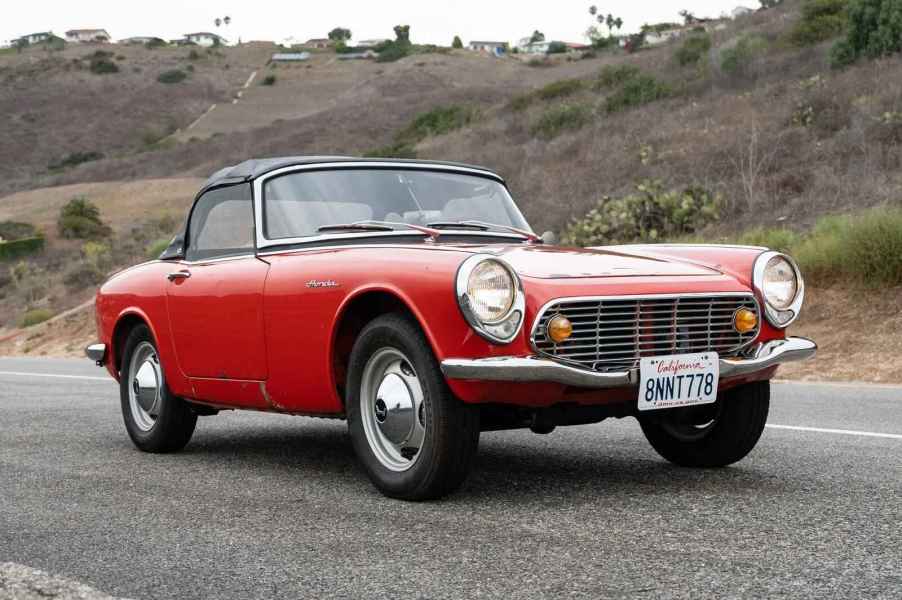
3 Honda Sports Cars You Probably Never Knew Existed
When you think of Honda, you probably think of models like the CR-V, Civic, and Accord. We don’t blame you, considering those models are the Japanese automaker’s most popular ones. However, did you know that Honda used to make sports cars? It did. Here are three that you probably never knew existed.
The Honda S600 was the genesis of the brand’s sporty roadsters
Honda’s first car, a mini truck called the T360, was produced in 1963. Four months later, the S500 was born. It was a small roadster that proved to be a good start for the brand, but it was short-lived. Honda only produced 1,363 S500 units. Moreover, it was only for the Japanese market, so it failed to become a mass-produced model.
The next year, Honda built the S600, which came in roadster and coupe form. This model was stunning. It has two doors, large circular headlights, and a sloping hood that gives it a classic sports car shape. It was also lightweight and tiny, which meant that it was fun to toss around in the corners. But it also lacked in the performance department.
Under the hood of the S600 was a 0.6-liter, four-stroke carbureted engine that produced only 58 hp. However, that tiny engine could rev to 9,000 rpm. It was mated to a four-speed manual transmission that routed the power to the rear wheels. Obviously, this is still a recipe for driving fun. One thing’s for sure; the Honda S600 paved the way for other sports cars that the Japanese automaker would develop in the coming years.

The Honda S800 carried the torch a couple of years later
In 1966, Honda built the S800 – another roadster – which was intended for the U.S. markets. Unfortunately, it never made it to our shores, but it made it to Britain to compete with other small roadsters like the MG Midget and Austin-Healey Sprite.
The S800 was small and lightweight like its predecessor, but it came with a slightly larger 791cc engine that produced a whopping 70 hp at a staggering 9,500 rpm. That engine was mated to a four-speed synchromesh manual transmission that routed the power to the rear wheels. Like the S600, the Honda S800 was not a powerhouse by today’s standards, but it helped put the automaker on the map in places like Europe, which was needed at the time.

Those little roadsters gave way to the famed Honda S2000
Now that we’re familiar with Honda’s tiny roadster, we can see why the automaker eventually produced the famed S2000. For the unaware, the Honda S2000 was launched for the new millennium and paid homage to the original S600. The S2000 featured a driver-centric cockpit layout and a digital instrument display reminiscent of Honda’s F1 car in the 1990s.
Under its hood was a naturally aspirated 2.0-liter engine that made 237 hp and 153 lb-ft of torque, which doesn’t sound like much. However, the fun came via a 9,000 rpm redline and a slick-shifting six-speed manual transmission that sent the power to the rear wheels.
The S2000 also had a 50:50 weight distribution and racecar-inspired bracing to make it an avid performer on the track and the street. Honda made revisions to the S2000 for the 2004 model year, giving it a bump in power and displacement in addition to some wheel and suspension tweaks. Sadly, the Honda S2000 was discontinued in 2009, but enthusiasts have their fingers crossed that it will make a long-awaited return soon.

Honda sports cars that you may have never known about
Although Honda currently produces the Civic Si and Type R, which are amazing sports cars in their own ways, they’ll never be the same as a tried-and-true roadster. Cars like the Honda S600, S800, and S2000 prove that you don’t need much power to have fun. We just hope that Honda will someday make other sports cars like those.
This article was originally published on December 11, 2022, and was updated for freshness on June 10, 2024.



